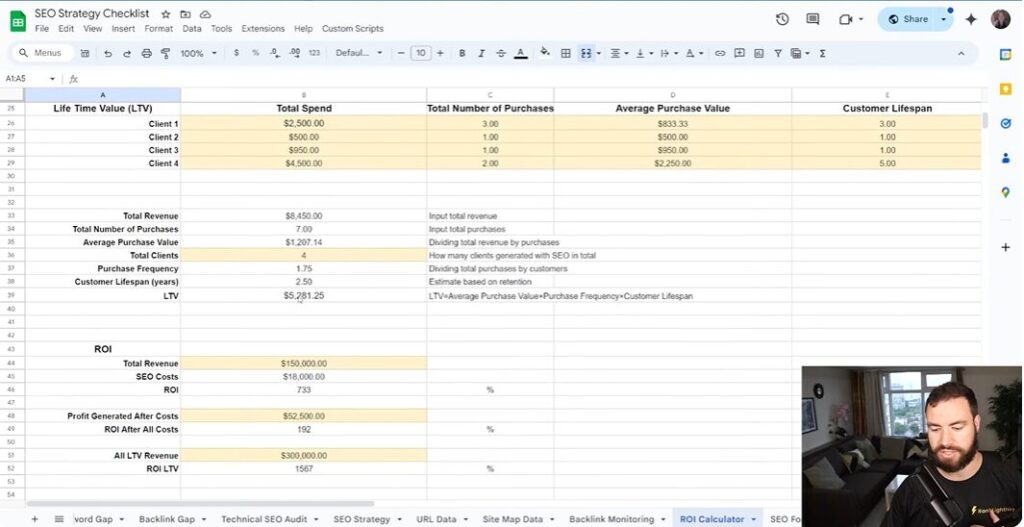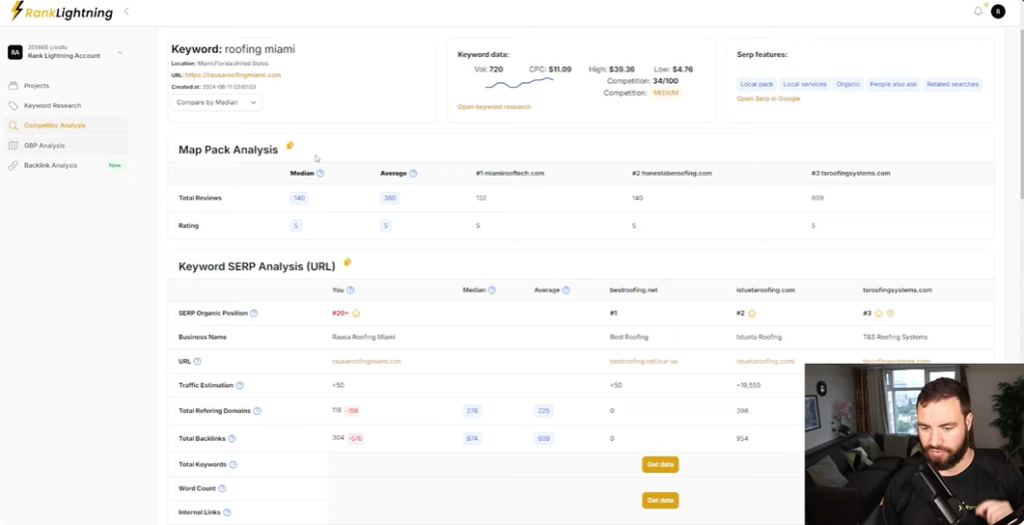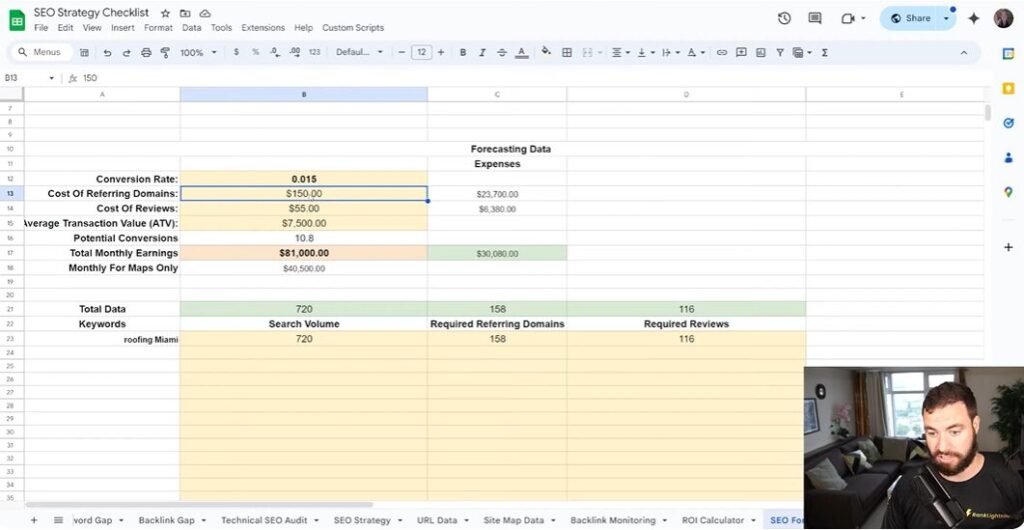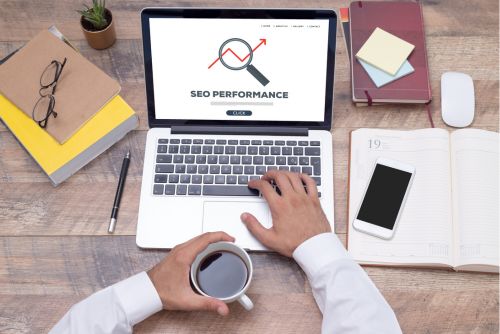Let me take you back to my early days in my journey as a digital marketing agency when I stumbled upon the power of SEO forecasting. It wasn’t just about keywords; it was about understanding the potential revenue from my SEO efforts. Armed with Google Sheets and a custom tool I created, I uncovered strategies that changed the way I approached local businesses. In this article, we will learn how to forecast SEO growth.
TL;DR: You can use SEO forecasting tools like Google Sheets to estimate revenue and determine the ROI for local SEO efforts. This guide shares insights and charts to help visualize and understand the process effectively.
Table of Contents
The Importance Of SEO Forecasting
Why Businesses Need To Consider SEO Forecasting
In today’s digital realm, SEO isn’t just another marketing strategy - it's crucial for business survival. Why, you ask? Well, developing a strong SEO forecast helps businesses identify potential return on investment (ROI). This isn't about guesswork. It's about informed decisions. With the rising complexities and costs associated with SEO, adopting a clear forecasting method gives your business a competitive edge.
When I first paved my way into SEO forecasting, I was surprised by its importance. The landscape has changed. Back in the day, getting to the top of search results was straightforward and relatively cheap. But not anymore! Now, it demands a strategic approach akin to traditional business investments.
Lessons Learned From My First SEO Forecasting Attempt
My initial attempt at SEO forecasting was like diving into uncharted waters. At first, I floundered. I learned quickly that utilizing tools and frameworks is key. I created a Google Sheets template that streamlined the process immensely. I remember thinking, “How did I manage without this?” These sheets allow for the input of vital metrics, including conversion rates, backlink costs, average transaction values, and potential conversions.
One important lesson? Always start with conservative estimates. For instance, I chose the keyword “Roofing Miami” to demonstrate how to input data effectively. Through this exercise, I realized that understanding competitor metrics through API was essential. Analyzing factors like the number of reviews and referring domains sharpened my focus on what’s realistic, and honestly, it felt empowering.
SEO As A Serious Business Investment, Not A Hobby
Many treat SEO as a side project or hobby. This approach is a huge mistake. SEO is as serious as any other business investment. Take it from me; if you want to see real results, you need to treat it that way. Imagine investing \$10,000 into SEO, but your potential earnings soar to $80,000. Indeed, SEO is an essential part of business growth. That’s a no-brainer!
By forecasting, we gauge the weight of our investments. Tools like the spreadsheet I designed help businesses visualize costs against potential income. It’s all about establishing that clear understanding, and that’s what encourages healthy discussions with stakeholders. I believe that with every forecast, you’re equipping yourself with the data necessary to advocate for your SEO initiatives. Don’t skimp on this step!
In doing this, we create a foundation on which realistic expectations can be set. Remember, SEO can seem daunting, but breaking down complex calculations into bite-sized bits makes it manageable. I can testify, understanding the average transaction value (often around $7,500 for roofing companies) allows for accurate potential return assessments.
If you take SEO forecasting seriously from the get-go, you're building a roadmap towards effective and strategic decision-making.
Getting Started With Google Sheets For SEO

When considering SEO services, Google Sheets can be a game changer. I’ve found it incredibly useful for organizing data, forecasting, and tracking key performance indicators. Here you can organize information pertaining to website traffic, keyword performance, and such. So, let’s break it down. Here’s how to set up your spreadsheet for maximum impact.
1. Setting Up The Spreadsheet For Everyone
First things first: your spreadsheet needs to be accessible. Whether you’re working with a team or solo, setting up a public or shared Google Sheet is crucial. This way, everyone can contribute or view the data. Think of it like a communal garden. Everyone adds their own touch, and when well cared for, it grows beautifully.
- Create a clear structure: Start with tabs for different metrics. This could include SEO Forecasting ROI, Keyword Research, and Competitor Analysis.
- Utilize templates: Leverage pre-designed sheets available online. They save time! I recommend starting with a simple keyword tracking template.
- Incorporate visual elements: Use charts or graphs for quick insights. A well-placed pie chart can make your data more digestible.
2. Key Metrics To Track In Your Results And Overall SEO Journey
Now, what should you be focusing on? With SEO, there’s a lot of data to sift through. I suggest honing in on these metrics:
- Average Transaction Value (ATV): Knowing the ATV helps in measuring potential returns. For instance, in roofing companies, it can be around $7,500.
- Conversion Rates: A conservative starting point is around 1.5% for local businesses. Understanding this is critical, as higher rankings yield more leads.
- Search Volume: Always assess how often your target keywords are being searched. Higher search volumes can lead to increased traffic!
3. Inputting Data Effectively And Efficiently
The way you input information can make or break your analysis. Keep these tips in mind:
- Batch your data input: Instead of updating every time you receive new data, set a weekly or monthly schedule for updates.
- Be consistent: Make sure you’re using the same format for inputs. Consistency ensures accuracy in your SEO forecasting.
- Use formulas: Familiarize yourself with basic formulas like SUM or AVERAGE for automatic calculations. They save a ton of time!
As I always say, “We can't have a sound SEO strategy without understanding the data behind it.”
By utilizing Google Sheets for data organization, you can not only track your progress but also forecast future performance effectively. You can easily understand and analyze important information such as organic traffic, keyword rankings, and more.
Understanding Key Metrics In Local SEO

What To Look For In Search Volumes And Site Rankings
When you want to improve your local SEO, one of the first things I consider is search volume. What does this number even mean? Simply put, it shows how many times a particular keyword is searched in a specific period. For instance, if the keyword "Roofing Miami" has a search volume of 1,000, it means people are actively looking for roofing services. High volumes of traffic can indicate strong demand, but they don't tell the whole story.
Next, we must examine rankings. What's the point of having a high search volume if my website isn’t ranking in the top results? I strive to be among the first three listings in search engines. Some experts implement strategies to boost rankings through increasing organic traffic to a SaaS website. According to recent studies, about 75% of users don’t scroll past the first page. This is why understanding not just volume, but where I rank for relevant keywords matters significantly.
Essential Metrics: Referring Domains And Required Reviews
- Referring Domains: These are other websites that link to mine. They are crucial for enhancing credibility and boosting search rankings. More referring domains typically mean more authority.
- Required Reviews: Online reviews can make or break my local SEO. In fact, I aim for at least 10 positive reviews before I feel competitive. Reviews not only build trust with potential clients but also signal to search engines that I'm a reliable choice.
How To Distinguish Between Average And Median
Now, this is where things can get tricky. I remember when I first started understanding metrics. I often confused average with median. Average simply adds up all the numbers and divides by the total. If there’s one extreme high or low value, it skews the average dramatically.
On the other hand, the median is the middle value. It’s much more reliable when comparing things like the number of reviews. If one competitor has 1,000 reviews, while others have 10, the average can be misleading. Instead, focusing on the median gives me a clearer picture of what’s typical in my industry.
Personal Anecdote About Metrics Misunderstanding
Let me share a little story. Early in my SEO journey, I overlooked the importance of search volume and ranking. I thought, “I have a beautiful website. It’ll naturally rank!” Boy, was I wrong. My site barely saw any website traffic!
After tons of research and a lot of trial and error, I learned to analyze my keywords, metrics, and the competition. Only then did I start seeing results. This journey taught me that understanding key metrics is not just beneficial; it’s essential for success in local SEO.
Forecasting Organic Traffic
Predicting organic traffic for your website is essential for creating effective SEO plans and strategies. By examining historical data, analytics, and current trends, businesses can uncover insights into potential traffic patterns, which helps them make informed choices about content creation, keyword search, and overall marketing efforts. Data such as keyword performance, traffic analysis, and rankings are important. Understanding these forecasts allows organizations to allocate resources more effectively and focus on initiatives that are likely to deliver the best returns in terms of visibility in search engine results and engagement.
The ability to predict organic traffic not only helps in optimizing existing content but also significantly influences future SEO strategies. By pinpointing which topics and keywords are expected to draw more traffic and visitors, companies can customize their content development to match user interests and search behaviors. This proactive strategy ensures that businesses stay competitive in their markets, enabling them to quickly adapt to changes in search engine algorithms and consumer preferences.
Moreover, forecasting organic traffic of your website can improve the overall success of an SEO campaign by establishing measurable goals and benchmarks. By setting realistic expectations based on analytics and data-driven insights, organizations can monitor their progress and make necessary adjustments to their strategies. This ongoing process encourages continuous improvement, ultimately resulting in greater organic visibility, higher conversion rates, top rank in search engines, and a more robust online presence.
The Cost Of Referring Domains And Reviews

Breaking Down The Investments
When we dive into the world of SEO, the first thing we notice is a critical question: What are the actual costs? I often find myself breaking down the investments in two primary areas: referring domains and reviews.
- Referring Domains: Think of these as bridges that connect your website to others. Each bridge can be costly. On average, acquiring a quality referring domain might set you back between $200 and $1,000, depending on its authority.
- Reviews: They’re the gold stars of your online presence. Soliciting reviews can cost time and resources, especially if you're aiming for genuine feedback. Consider using platforms like Trustpilot or Yelp, which may have associated fees for using premium features.
So, what’s the bottom line? Every investment you make in domains and reviews should be viewed through the lens of potential returns. If you spend $1,000 on a reputable referring domain, but it boosts your site's organic traffic by 30%, that’s a win!
Ethical Considerations
Now, let’s talk about ethics when it comes to obtaining reviews. Have you ever been tempted to buy reviews? Here’s the reality: It can be risky. The market is filled with offers to sell fake reviews. But this can backfire.
“Integrity is doing the right thing, even when no one is watching.” – C.S. Lewis
It’s essential to build a strategy that values honesty. Seek authentic reviews by engaging with your customers post-purchase. This may require effort, but the results are far more rewarding. Genuine reviews foster trust.
Tools To Gauge Market Rates
I can’t stress how invaluable tools can be in this process. For instance, my go-to resources include:
Ahrefs– Great for checking referring domains in your niche.SEMrush– A fantastic tool to gauge market competitors and their review strategies.Google Sheets– Use this lightweight spreadsheet to keep track of your investments vs. returns.
With these tools in hand, we can get a snapshot of where we stand and make informed decisions. It’s all about making your budget work for you and ensuring your SEO efforts are both strategic and effective.
Creating Your SEO Forecast

When it comes to forecasting your SEO efforts, running your data through a table can be a game changer. So, how to calculate and forecast SEO growth? First, I recommend using a simple Google Sheets template that I created. This tool can help visualize key metrics and make everything easier to digest. With my Rank Lightning tool, we can streamline this entire process.
How To Run Your Data Through The Table
Here's how you can do it:
- Open the Google Sheets template.
- Input key metrics: conversion rates, average transaction values, costs of referring domains, and expected conversions.
- Navigate to the “SEO Forecasting ROI” tab.
Once these metrics are in place, you can see a clear picture of potential returns on your SEO investment. For instance, let's say we're focusing on the keyword “Roofing Miami.” By entering relevant data, we'll get insights into whether our SEO efforts are really worth it.
Understanding And Managing Expectations
Another important aspect is understanding how to manage our expectations. It's easy to get carried away with potential outcomes. We need to be realistic. A conservative average conversion rate of 1.5% for local businesses, although minimal, provides a cushion for realistically gauging lead generation effectiveness.
Ask yourself, what happens if we don't hit that 1.5%? Knowing the numbers helps you make informed decisions.
Live Data Vs. Historical Data
Finally, let's talk about data types. Using live data vs. historical data for analysis is crucial. Live data provides real-time insights and analytics, but historical data helps us understand trends over time. How do we strike that balance? I suggest starting with live data for immediate insights, then layering in historical analysis to capture broader trends. This dual approach enriches our understanding of market dynamics.
SEO forecasting uses a data-driven approach to predict how a site will perform in organic search over time. This process involves analyzing both current and past data, such as keyword rankings, organic traffic, click-through rates (CTR), and search volumes, to estimate the number of visitors a website is expected to attract within a specific period.
By incorporating these elements, we can create a thorough SEO forecast. Your business deserves clear analysis, backed by data, leading to informed decisions! It's time to bring clarity to the often murky world of SEO forecasting.
Pros And Cons You Get When You Forecast SEO

The Advantages Of Forecasting SEO
When I think about SEO forecasting, the first thing that comes to mind is clarity. It’s like having a roadmap. But what exactly do we gain from this practice?
- Strategic Planning: Forecasting allows you to understand the potential outcomes clearly. You can plan your SEO strategies based on realistic expectations since SEO forecasting uses data-backed techniques.
- Budget Justification: Predicting the revenue generated by specific SEO campaigns or channels can help you justify your SEO budget. If I tell you the potential earnings are huge, you're likely going to want to invest more, right?
- Measurable Goals: Forecasting provides concrete metrics, which help set measurable goals. Are we shooting for the stars? Or just trying to improve?
- Competitive Advantage: Knowing what to expect lets you adjust your strategies proactively, keeping you ahead of your website competitors.
- Enhanced Understanding: By analyzing conversion rates and other metrics, you gain understanding into your business that may have been overlooked.
As Ron from Osborne Digital Marketing pointed out, a simple Google Sheets template can help with these calculations. You enter essential data like conversion rates, and voilà! You get a rough estimate of the ROI of your SEO efforts.
The Disadvantages Of Forecasting SEO
Now, while forecasting has its perks, it’s important to acknowledge the downsides. Nothing is perfect after all. What are the potential pitfalls?
- Uncertain variables: The SEO landscape is ever-changing. Algorithms update, markets shift, and today’s data might not apply tomorrow.
- Over optimism: It’s easy to get carried away with high predictions. What if the actual results fall short?
- Complex calculations: If you’re like me, complex spreadsheets can be overwhelming. It’s easy to get lost in the numbers.
- Not all leads convert: Relying on average conversion rates can be misleading. Some leads might never convert, so planning solely based on these stats can inflate your forecasts.
- Competitor actions: Your competitors can also change their strategies, leading to unexpected outcomes.
As with any forecasting or predictive tool, it’s essential to balance optimism and realism. Understanding both the benefits and limitations lets you navigate the SEO landscape more effectively.
Types Of SEO Forecasting
Now that we have discussed the basics of SEO Forecasting, let's get an overview of the types of of forecasting that you should have an idea about.
Keyword Forecasting
Keyword forecasting is a strategic method that focuses on predicting how specific keywords will perform in SEO and digital marketing. This approach can offer valuable insights into potential traffic, user intent, and market trends, enabling businesses to adjust their content and advertising strategies accordingly. By examining historical information and current search trends, marketers can pinpoint which keywords are likely to become popular, thus optimizing their campaigns for improved visibility and engagement.
However, despite the many benefits of keyword forecasting, it does come with its challenges. A major issue is the unpredictable nature of search behavior, which can be affected by various external factors like seasonality, emerging keyword trends, and shifts in consumer preferences. Furthermore, depending too heavily on forecasting models can lead to overconfidence in the predicted results, which might cause mishandling of resources or missed opportunities if actual performance diverges from expectations.
In summary, keyword forecasting is a valuable tool for enhancing digital marketing efforts for your site, but it requires careful attention to its limitations. Businesses need to balance the insights gained from forecasting with a flexible strategy that allows them to adapt to real-time market changes. By merging data-driven predictions with continuous analysis and responsiveness, organizations can enhance the effectiveness of their keyword strategies while reducing the risks linked to forecasting inaccuracies.
Statistical Forecasting
Statistical forecasting has its pros and cons that deserve attention. On the positive side, it leverages historical data to spot trends in site traffic, keyword rankings, and click-through rate (CTR) allowing organizations to make educated predictions about future events. This approach can enhance decision-making and improve resource allocation, ultimately boosting efficiency and effectiveness.
On the flip side, statistical forecasting has its drawbacks. Relying on historical information about a site's performance can lead to inaccuracies if past trends change or if unexpected variables come into play. Moreover, the complexity of statistical models can lead to misinterpretation or overfitting, which may undermine the reliability of the forecasts. Therefore, while statistical forecasting can be a useful tool, it’s important to use it cautiously and be aware of its potential limitations.
Common Misconceptions About SEO Success

The Myth That All Reviews Guarantee Higher Rankings For Your Website
Let’s start by addressing a big misconception: many people believe that accumulating reviews alone will instantly boost their site’s ranking. While it’s true that reviews matter, they are just one piece of a larger puzzle. Think of it like a recipe; you need the right mix of ingredients to bake a delicious cake.
- Quality Over Quantity: Having a few glowing reviews is better than tons of mediocre ones.
- Context Matters: Reviews reflect user experience but the relevance of your service also plays a role.
- Algorithm Changes: Search engines continuously evolve. A surge in reviews might not lead to the expected ranking improvements.
In short, while reviews are important, they shouldn't be the sole strategy for improving ranking. It’s about all aspects of SEO working together.
Unpacking The Reality Behind Conversion Rates
Now, let’s talk about conversion rates. The numbers can be enlightening, yet often misunderstood. You might think, “If I attract more visitors and traffic on my website, sales will naturally increase.” But what if I told you it’s more complicated? Just because organic website traffic spikes doesn’t guarantee conversions.
To illustrate, I suggest a target conversion rate of around 1.5% for local businesses. This isn’t a magical number; it's a conservative estimate. You can derive a lot of insight from understanding your average transaction value (ATV). For example, if your ATV is $7,500 for roofing companies, that small percentage can lead to significant revenue.
Client Expectations: Managing Their Understanding Of SEO
Lastly, let’s discuss client expectations regarding SEO. Sometimes, clients expect quick results, forgetting that SEO is a long-term game. Like tending a garden, you may not see blooms overnight.
- Setting Realistic Goals: Educate clients on what is achievable in the short term versus the long term.
- Highlighting the Process: Explain the importance of various elements like organic traffic, quality content, keyword research, backlinks, and SEO audits.
- Transparency is Key: Share knowledge and understanding on how search engines function to promote understanding.
I’ve found that when clients grasp the complexities involved, they become more supportive of the strategies we propose. It builds trust and leads to collaborative success.
Ultimately, SEO is about striking the right balance. It’s crucial to bust these myths and educate both ourselves and our clients. By doing so, we can navigate the landscape of SEO with confidence and clarity.
Final Thoughts And Next Steps
As we wrap up your first SEO forecast, I want to emphasize how important this experience has been. Completing your traffic forecast is not just about dollars and cents; it’s about understanding the journey ahead. It requires a lot of analysis and understanding about website traffic analytics, keyword performance, ranking, and more. Remember, each data point you entered was a step towards mastering local SEO. When you learned how to forecast SEO growth for future trends, this is where your business growth can truly begin to flourish.
Now, it’s time for reflection and refinement. You’ve taken a significant step in forecasting the potential return on investment for your SEO efforts, and I encourage you to continue refining your process. Consider this analogy: think of SEO forecasting like honing a sharp blade. The more you practice and adjust your technique, the better the edge you'll have. So don’t shy away from experimenting with your inputs or methods. Are there new metrics you can add? Is there a better way to visualize your data?
Additionally, never underestimate the power of continuous learning. There are numerous resources available that can enhance your understanding of SEO forecasting and local SEO strategies. Websites, forums, and even online courses can vastly improve your knowledge. I invite you to explore communities where professionals share their techniques and tips. Join discussions and seek out mentors; these relationships can provide valuable guidance that might change how you look at SEO altogether.
If you’re looking for tools, my Google Sheets template and Rank Lightning are fantastic resources. They can link you to actionable plans that clarify your strategy. Don’t forget to reach out to me for a free 15-minute consultation if you want to know more about handling ads, PPC, CTR, and backlink gaps. I’m here to help!
In summary, forecast and assess traffic or keyword performance. Refine and learn. These steps will guide you as you continue your local SEO journey. I’m excited to see where your efforts take you! Let’s commit to elevating your SEO success, one forecast at a time.




